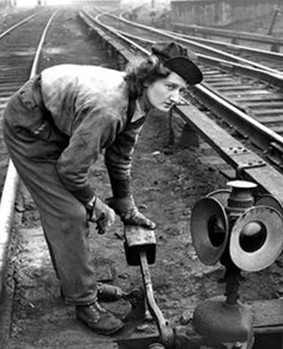Women’s Economic Rights Expanded and Their Responsibilities Morphed
Rights:
As the war raged on, the gender roles shifted as woman slowly began taking on the role of men, meaning they were now also the breadwinners. Even positions that were formerly off limits to women opened up. Women started taking on more dangerous and intense jobs to help contribute to the war effort. This also lead to society's expectation of women adapting to fit the new gender roles.

Woman working as a switch tender, The Historic Railpark
This change was necessary if the United States wanted to meet the demands for war supplies. It was estimated that an extra eighteen million Americans would have to join the workforce in order to meet manufacturing demands, Even critical industries such as farming were affected, which would lead to further food scarcity on top of the ongoing rationing. Farming professionals believed that 75% of farms would be under supplied with workers, surely putting a strain on the agriculture industry. Women proudly came forward and provided their assistance to such farms because they believed it was necessary to help serve their country.
Many women also began working in factories that produced war supplies such as guns and airplane parts. However many of these women were severely inexperienced, which made working conditions even more dangerous. Peggy Terry, who was one of the millions of female factory workers during this time period, recalled that "some of the women had breathing problems…The fumes from these rags—it was like breathing cleaning fluid. It burned the nose and throat.” (Americans At War) With being exposed to such harmful substances, there is no doubt many women developed health issues. Many women also had their basic human rights violated while at work, such as access to the bathroom and water. Terry had a similar experience, saying that in the factory she worked at, "Coca-Cola and Dr. Pepper were allowed in every building, but not a drop of water…We couldn't leave to go to the bathroom, 'cause it was way the heck over there.” (Americans At War). This negligence showed that protecting their basic rights was not a priority, they were only focused on production and money.

Peggy Terry, Women in Peace
Responsibilities:
Women maintained the previous responsibilities they had prior to the war such as managing chores and taking care of their children. However they would also gain new responsibilities such as rationing food and budgeting. Managing all of these new and old responsibilities was challenging for many women, which is why daycares were built. Daycares helped encourage women to work since their children could be watched. However many Americans did not like the idea of daycares. Many women preferred to leave their children with relatives who didn’t have a job because they believed they were harmful to the development of their children. This would lead to a large portion of the daycares not even being halfway full, even when the Federal Works Agency spent $50 million on their development to ensure accessibility and quality. It is clear that the federal government had some impact on the gender roles and convincing women to join the workforce through the construction of daycares. But were there any other ways the American government influenced the public?